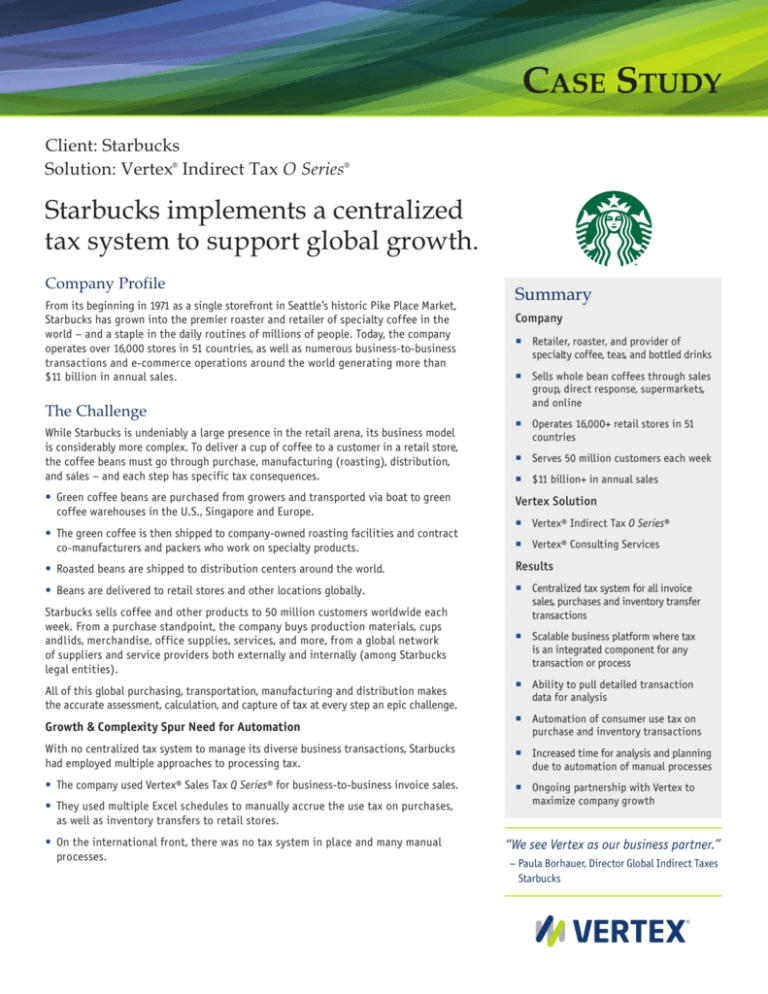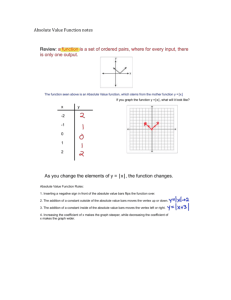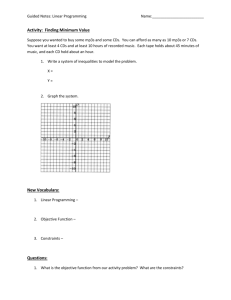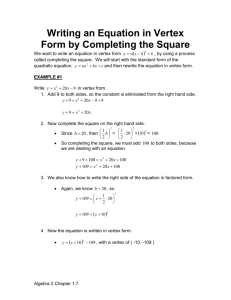
Client: Starbucks
Solution: Vertex® Indirect Tax O Series®
Starbucks implements a centralized
tax system to support global growth.
Company Profile
From its beginning in 1971 as a single storefront in Seattle’s historic Pike Place Market,
Starbucks has grown into the premier roaster and retailer of specialty coffee in the
world – and a staple in the daily routines of millions of people. Today, the company
operates over 16,000 stores in 51 countries, as well as numerous business-to-business
transactions and e-commerce operations around the world generating more than
$11 billion in annual sales.
The Challenge
While Starbucks is undeniably a large presence in the retail arena, its business model
is considerably more complex. To deliver a cup of coffee to a customer in a retail store,
the coffee beans must go through purchase, manufacturing (roasting), distribution,
and sales – and each step has specific tax consequences.
CASE STUDY
Summary
Company
Retailer, roaster, and provider of
specialty coffee, teas, and bottled drinks
Sells whole bean coffees through sales
group, direct response, supermarkets,
and online
Operates 16,000+ retail stores in 51
countries
Serves 50 million customers each week
$11 billion+ in annual sales
• Green coffee beans are purchased from growers and transported via boat to green
coffee warehouses in the U.S., Singapore and Europe.
Vertex Solution
• The green coffee is then shipped to company-owned roasting facilities and contract
co-manufacturers and packers who work on specialty products.
Vertex® Consulting Services
• Roasted beans are shipped to distribution centers around the world.
• Beans are delivered to retail stores and other locations globally.
Starbucks sells coffee and other products to 50 million customers worldwide each
week. From a purchase standpoint, the company buys production materials, cups
and lids, merchandise, office supplies, services, and more, from a global network
of suppliers and service providers both externally and internally (among Starbucks
legal entities).
All of this global purchasing, transportation, manufacturing and distribution makes
the accurate assessment, calculation, and capture of tax at every step an epic challenge.
Growth & Complexity Spur Need for Automation
With no centralized tax system to manage its diverse business transactions, Starbucks
had employed multiple approaches to processing tax.
• The company used Vertex® Sales Tax Q Series® for business-to-business invoice sales.
• They used multiple Excel schedules to manually accrue the use tax on purchases,
as well as inventory transfers to retail stores.
• On the international front, there was no tax system in place and many manual
processes.
Vertex® Indirect Tax O Series®
Results
Centralized tax system for all invoice
sales, purchases and inventory transfer
transactions
Scalable business platform where tax
is an integrated component for any
transaction or process
Ability to pull detailed transaction
data for analysis
Automation of consumer use tax on
purchase and inventory transactions
Increased time for analysis and planning
due to automation of manual processes
Ongoing partnership with Vertex to
maximize company growth
“We see Vertex as our business partner.”
– Paula Borhauer, Director Global Indirect Taxes
Starbucks
Starbucks implements a centralized tax system to support global growth.
The Challenge (continued)
Given the scale, complexity, and global nature of the business,
Starbucks realized that the manual processes put accuracy
at risk, increased tax exposure and audit risk. For example,
use tax processes were completed by a non-tax professional
with guidelines provided by the tax team – creating more
possibilities for human error.
Starbucks’ processes also lacked the flexibility and scalability
to support current or future business growth. It required
the ability to set up and evaluate receipt settlements with
suppliers. Due to system constraints, the company also needed
the ability to pull detailed transaction data. Use tax accrual
on inventory transfers typically required three days to perform
due to manual input and the use of spreadsheets.
These and other situations spurred the demand for an
automated solution for indirect tax.
Integrating Tax into the ERP Upgrade
To address the increasing scale and complexity of its global
operations, the company was embarking on an Oracle ERP
upgrade, which presented an opportunity to integrate,
centralize and standardize the accounts payable, accounts
receivable and inventory processes across all regions of its
operations. While Vertex® Sales Tax Q Series® had previously
provided business-to-business transactional-level tax
management for Starbucks in the U.S., the company would
integrate Vertex® Indirect Tax O Series® into the Oracle ERP
upgrade to enable them to get to transactional level consumer
use and inventory tax evaluation, which had previously been
impossible with the older systems, according to Sheryl
Bennett-Holland, Systems Analyst Lead at Starbucks.
“Our goal was to create a scalable business platform
to accommodate business growth and change where
tax was an integrated component for any transaction
or process – not an afterthought.”
– Sheryl Bennett-Holland
System Analyst Lead
Starbucks
“Our goal was to create a scalable business platform to
accommodate business growth and change where tax was an
integrated component for any transaction or process – not
an afterthought,” said Bennett-Holland.
The first area to go live was the Starbucks’ Europe-Middle
East-Africa (EMEA) region. The intentional deployment in a
smaller region provided the Starbucks team an opportunity
to learn the Vertex solution, and the tax link technology.
Paving the Way for Future Growth
The integration of the Vertex and Oracle platforms
has provided a framework the company can leverage
for future initiatives. For example, the company
recently implemented an Oracle iStore module in the
ERP, and an online ordering system for its food
services and licensed store groups. Because iStore
integrates with the existing ERP system using the
components built to link with Vertex, Starbucks
expects that the tax evaluations through Vertex will
be done on every transaction – without requiring
any “one-off” processes.
“We faced a lot of challenges in this upgrade – doing both
the ERP and Vertex implementation at the same time,” recalls
Bennett-Holland. “Upgrading both together presented a
continuously changing target, as other teams changed their
designs to meet their business needs in their space.”
Mapping the Data Flows
Given the scope of the project, with such a large number of
departments and tax laws, the development and testing teams
were challenged with multiple design changes to anticipate
all the possible processing scenarios that the Vertex system
might have to handle.
The sheer volume of data passing through the systems posed
a reporting challenge. To better visualize the flow of data
for troubleshooting during deployment, the Starbucks team
laid out a flow diagram with pictures of the data points
that would be passed to the Vertex system, and where they
originated from in Oracle for all invoice types and loads.
Starbucks went live with Vertex O Series for value added tax
(VAT) in November 2008 and with Vertex O Series for sales
and consumer use tax in April 2011.
Transforming & Elevating the Role of Tax
With the two-pronged deployment completed, all of Starbucks
invoice sales, purchases and inventory transfer transactions
are now processed through a centralized tax system. The
advent of this visibility, coupled with automation of many
manual processes, has fundamentally changed the company’s
tax function.
“As a tax professional, I’m very excited that we have the ability
to see all transactions,” said Ryan Meas, Manager of Sales and
Use Tax at Starbucks. “We’re able to trace all transactions, and
report on all transactions related to accounts receivable,
accounts payable, and inventory transactions.”
2
Starbucks implements a centralized tax system to support global growth.
Transforming & Elevating the Role of Tax
(continued)
Prior to the Vertex implementation, the Starbucks tax team
spent an inordinate amount of time performing calculations
on tax data. “Now we spend time analyzing transactional
data instead of performing manual tax calculations, which
allows us to be more proactive than reactive in addressing
tax issues,” said Meas. “This adds value to our company, and
also enhances our partners’ skill sets.”
He continues, “One of the biggest transformational changes
with this project is the use of tax automation on all purchases
and inventory transactions. Before this project, all purchases
were handled by a non-tax professional, and the inventory use
tax accrual process was done manually using spreadsheets.”
“The centralized, automated tax solution allows
us to be more flexible and scalable without adding
new resources each time there are new business
ventures.”
– Ryan Meas, Manager of Sales & Use Tax
Starbucks
The Ideal Implementation Team
Starbucks decided to combine the Vertex tax system upgrade
with their Oracle ERP upgrade. As with any enterprise-level
software update, the tandem upgrades presented a number
of technical and country-specific obstacles. One of the most
challenging issues was the inherent cross-functional knowledge
gaps between the software vendor (Vertex), the Starbucks IT
function, and the Starbucks tax department.
Cross-Functional Knowledge Needs
“Vertex people know their product, our IT people know our
unique infrastructure, and the tax department knows how
to navigate global tax regulations,” notes Brian Ugai, Vice
President, Tax & Customs at Starbucks. “Connecting those
dots and bridging the enormous knowledge gaps is extremely
challenging, and requires cross-functional knowledge across
all areas – and very talented people.”
As Starbucks embarked on the project, the team knew
project-level and ongoing service would be an important key
to success. One option was to use the implementation service
provided through the software providers or employ a third
party. A third-party service provider was already engaged for
the ERP implementation, and the prospect of enlisting another
outside firm and bringing them up to speed on the business,
the IT landscape – and Vertex – presented new challenges.
Ultimately, Starbucks engaged Vertex Consulting to provide
support around the tax system implementation.
The Vertex implementation mitigated potential human error
and reduced the inventory tax processing time from three
days to one and a half days. The Tax department can now be
more proactive when working with business units to identify
the business and tax impact of current and future initiatives.
“Vertex knows its product the best,” noted Ugai, “and what’s
in store for it going forward. Additionally, we needed someone
who had the inside knowledge of Vertex – someone who could
not only apply their knowledge of our business and IT
situations and challenges, but could identify problems and
rally the appropriate Vertex resources to solve them.”
“In addition,” add Meas, “The centralized, automated tax
solution allows us to be more flexible and scalable going
forward, without adding new resources each time there are
new business ventures.”
Working with their Vertex Technical Account Manager, or TAM,
prior to the implementation proved fortuitous. The Vertex
professional staff was already familiar with Starbucks IT and
tax departments and was ready to address the knowledge gaps
and issues encountered along the way.
Looking Ahead
The Vertex implementation enabled a strategic makeover
of the Starbucks’ tax department, and the company soon
identified additional areas for improvement with subsequent
implementations.
The next initiative involves upgrading both the EMEA and
North American regions to the Vertex® Indirect Tax O Series®
6.0 version. This standardization will simplify support for the
company’s IT organization, which will only need to support
one version of the solution, and apply uniform treatments
across all regions when future changes are required. In
addition to keeping up with releases and fixes, the company
plans to take advantage of Vertex platform integrations, such
as the exemption certificate manager and reporting analytics.
“Overall, this sets a foundation for easier business expansion,”
said Bennett-Holland.
Critical Support During Cutover
In preparing for implementation of Oracle and Vertex O Series,
Starbucks IT had strict support requirements for the cutover
period to prevent system failures and business interruption.
Vertex sent two support team members to Starbucks prior to
implementation for knowledge transfer on the Starbucks
specific tax link extensions supporting multiple Oracle
modules and countries. For the cutover period, Vertex support
and service teams worked with Starbucks tax and IT staff to
tailor the support hours and provide direct access to advanced
support team members. This flexibility to provide customized
service was critical for the cross-functional team managing
the implementation.
An Ongoing Partnership
The need to partner with a proven service provider –
particularly on the tax front – is especially important to
Starbucks. The partnership between the Starbucks and Vertex
teams goes far beyond the initial stages of implementation,
and empowers the Starbucks IT and tax teams to focus their
efforts on initiatives to drive the business as the company
grows and adds lines of business and products.
3
Starbucks implements a centralized tax system to support global growth.
Looking Ahead (continued)
About Vertex
A Valuable Partnership
Paula Borhauer, Director Global Indirect Taxes at Starbucks,
emphasizes the value of the partnership between Vertex
and Starbucks. “With Vertex, it’s not a situation where the
software is installed and then people involved in the
installation go away and you never see or talk to them again,”
explains Borhauer. “But, from my experience, that seems to
be the model with a lot of software installations. With tax,
you just can’t do that. You need a partner. Tax requirements
are constantly changing outside of our control. We’re
working with Vertex month after month, because there are
constant changes.”
With more than 30 years of experience, Vertex Inc. is the
leading provider of corporate enterprise tax solutions and
process management services worldwide.
Vertex solutions help companies streamline and integrate tax
provision and compliance processes, and leverage information
to discover new strategic tax savings across every major line
of business tax, including income, sales, consumer use, value
added, communications, and payroll. To serve its customers,
Vertex works in partnership with the world’s leading providers
of ERP software and related services.
“We see Vertex as our business partner,” says Borhauer. “We
went through this major ERP implementation, but now we’re
going through different upgrades and resolving new problems
that arise because we continue to adjust our IT infrastructure
or our business requirements change. Our business is very
dynamic – we’re growing and adding lines of business and
new products. So we need to adjust the Vertex system along
the way to meet those changes. This requires a team with
in-depth knowledge of the Vertex products and resources,
as well the Starbucks IT landscape and business model.”
Supporting Business Growth
Bennett-Holland Summarizes, “This is exactly the type of
foundational benefit we were hoping to get from the
implementation of Oracle and the Vertex O Series. And the
continuous upgrades will really position us to support new
growth and future business changes within Starbucks without
sacrificing tax accuracy and/or tax resources to do it.
Vertex Inc.
Vertex Global Tax Solutions Ltd.
Vertex Global Tax Solutions Brasil Ltda.
1041 Old Cassatt Road
Berwyn, PA 19312
United States
Phone: 610.640.4200
Toll-free: 800.355.3500
1 Furzeground Way, Stockley Park
Uxbridge UB11 1EZ
United Kingdom
Phone: +44 (0)20 8622 3053
Av. Dr. Chucri Zaidan, 940
16º andar – Market Place Tower II
04583-906 – São Paulo – Brazil
Phone: +55 11 5095.3433
Reg. in England and Wales. Reg. No. 5982877
©2015 Vertex Inc. All rights reserved. Vertex, the Vertex logo, Where taxation meets innovation and O Series are all registered trademarks
of Vertex Inc. All other trademarks are used for identification purposes and are properties of their respective owners. 01.15










